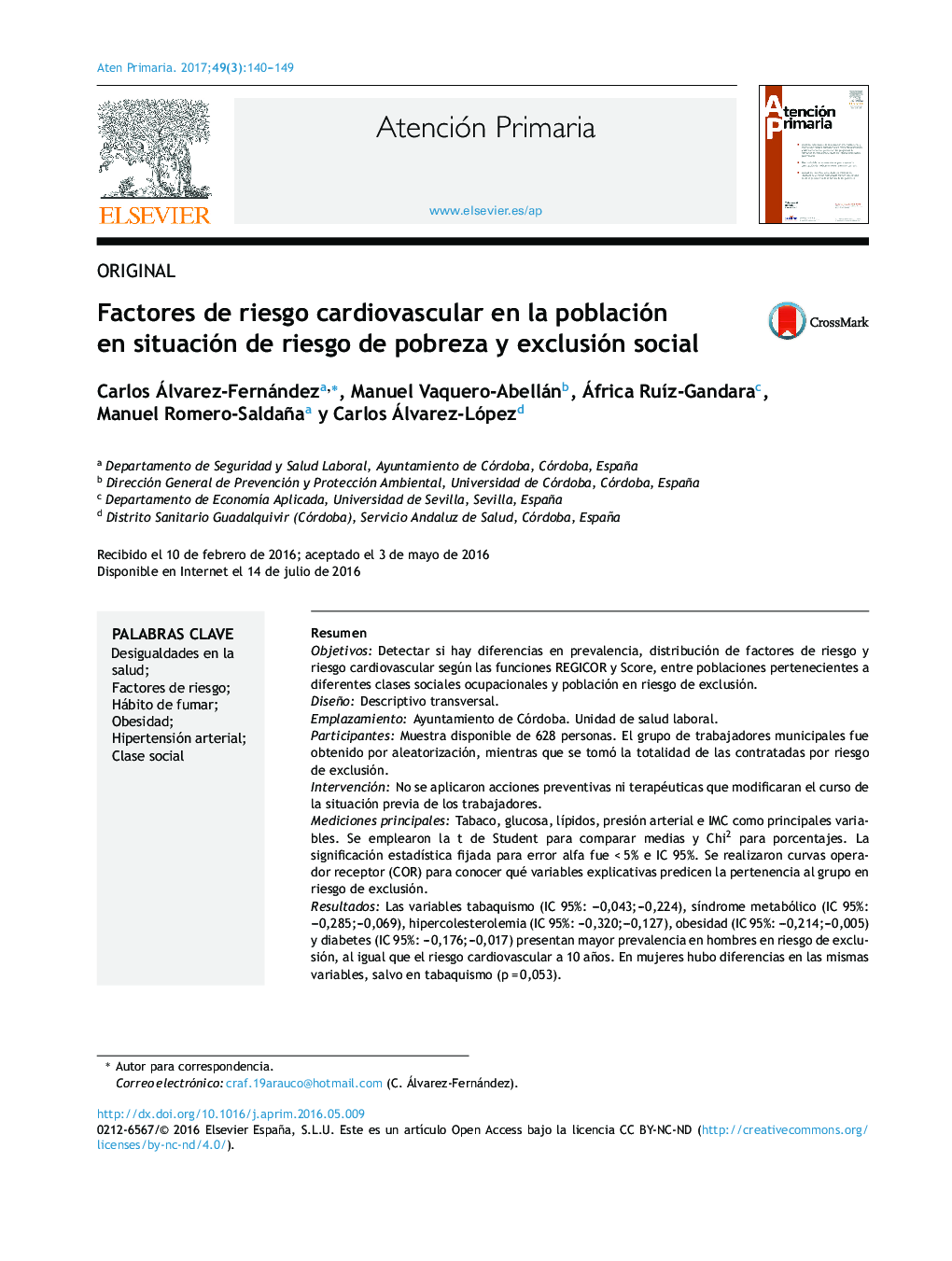| کد مقاله | کد نشریه | سال انتشار | مقاله انگلیسی | نسخه تمام متن |
|---|---|---|---|---|
| 5677985 | 1408563 | 2017 | 10 صفحه PDF | دانلود رایگان |
ResumenObjetivosDetectar si hay diferencias en prevalencia, distribución de factores de riesgo y riesgo cardiovascular según las funciones REGICOR y Score, entre poblaciones pertenecientes a diferentes clases sociales ocupacionales y población en riesgo de exclusión.DiseñoDescriptivo transversal.EmplazamientoAyuntamiento de Córdoba. Unidad de salud laboral.ParticipantesMuestra disponible de 628 personas. El grupo de trabajadores municipales fue obtenido por aleatorización, mientras que se tomó la totalidad de las contratadas por riesgo de exclusión.IntervenciónNo se aplicaron acciones preventivas ni terapéuticas que modificaran el curso de la situación previa de los trabajadores.Mediciones principalesTabaco, glucosa, lÃpidos, presión arterial e IMC como principales variables. Se emplearon la t de Student para comparar medias y Chi2 para porcentajes. La significación estadÃstica fijada para error alfa fue < 5% e IC 95%. Se realizaron curvas operador receptor (COR) para conocer qué variables explicativas predicen la pertenencia al grupo en riesgo de exclusión.ResultadosLas variables tabaquismo (IC 95%: -0,043;-0,224), sÃndrome metabólico (IC 95%: -0,285;-0,069), hipercolesterolemia (IC 95%: -0,320;-0,127), obesidad (IC 95%: -0,214;-0,005) y diabetes (IC 95%: -0,176;-0,017) presentan mayor prevalencia en hombres en riesgo de exclusión, al igual que el riesgo cardiovascular a 10 años. En mujeres hubo diferencias en las mismas variables, salvo en tabaquismo (p = 0,053).ConclusionesSe comprueba una desigual prevalencia de factores de riesgo cardiovascular en población en riesgo de exclusión. En un contexto de crisis social, los programas de prevención primaria dirigidos a la población más vulnerable son necesarios para mitigar la desigualdad.
GoalsDetect if there are differences in prevalence, distribution of cardiovascular risk factors and risk according to REGICOR and SCORE's function; between people belonging to different occupational classes and population at risk of social exclusion.DesignCross-sectional.SiteOccupational health unit of the City Hall of Córdoba.ParticipantsSample availability of 628 people, excluding 59 by age or incomplete data. The group of municipal workers was obtained randomly while all contracted exclusion risk was taken.InterventionNo preventive, diagnostic or therapeutic actions that modify the course of the previous situation of workers were applied.Main measurementsSmoke, glucose, lipids, blood pressure and BMI as main variables. T-student were used for comparison of means and percentages for Chi2. Statistical significance attached to an alpha error <Â 5% and confidence interval with a 95% security. Receiver operator curves (ROC) were employed to find out what explanatory variables predict group membership of workers at risk of exclusion.ResultsSmoking (95% CI: -.224;-.443), hypercholesterolemia (95% CI: -.127;-.320), obesity (95% CI: -.005;-0.214), diabetes (95% CI: -.060;-.211) and cardiovascular risk were higher in men at risk of exclusion. In women there were differences in the same variables except smoking (PÂ =Â .053).ConclusionsThe existence of inequalities in prevalence of cardiovascular risk factors is checked. In a context of social crisis, health promotion and primary prevention programs directing to the most vulnerable, they are needed to mit.
Journal: Atención Primaria - Volume 49, Issue 3, March 2017, Pages 140-149
